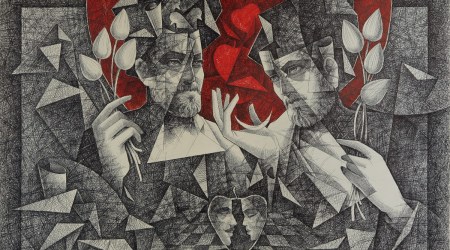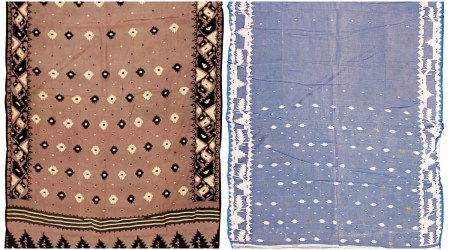 Artist: Gulammohammed Sheikh Title : Gandhi & Gama Medium : Acrylic on canvas Size : 113.5" x 245.5" Year : 2014 (Source: Gulammohammed Sheikh/Vadehra Art Gallery)
Artist: Gulammohammed Sheikh Title : Gandhi & Gama Medium : Acrylic on canvas Size : 113.5" x 245.5" Year : 2014 (Source: Gulammohammed Sheikh/Vadehra Art Gallery) Nandalal Bose
 Artist: Nandlal Bose
Artist: Nandlal BoseTitle: Bapuji
Medium:
Size:
Year: 1930 (Source: Nandalal Bose/National Gallery of Modern Art)
Trusted by Mahatma Gandhi as one who understood the pulse of the people, the Bengal artist was commissioned by him to create artwork for multiple Congress sessions, including the Lucknow session in 1935 and the Haripura session in 1938. Bose immortalised Gandhi in his linocut print of the leader walking with his stick during the Dandi March, protesting the tax on salt imposed by the British. The iconic 1930 print has remained a popular image.
SH Raza
 Artist : S H Raza
Artist : S H RazaTitle : Peed Parai
Medium : Acrylic on canvas size : 59″ x 59″
Year : 2013 (Credit: S H Raza/Vadehra Art Gallery)
SH Raza recalled accompanying his father to hear Gandhi address a public meeting in Mandla during the freedom struggle. He was eight then and did not remember what Gandhi said but the image of the Mahatma stayed with him. He continued to study Gandhian ideals and much later in life dedicated a series to him. Painted in 2013 after his return to India, the canvases in muted shades celebrate his teaching — if one of the works has the words Hey Ram, in another, titled Peed Parai, the canvas in brown and white is divided in equal parts, as Raza paints the words ‘Vaishnav jan toh tene kahiye’, from one of his favourite bhajans.
Gulammohammed Sheikh
 Artist: Gulammohammed Sheikh
Artist: Gulammohammed SheikhTitle : Gandhi & Gama
Medium : Acrylic on canvas
Size : 113.5″ x 245.5″
Year : 2014 (Source: Gulammohammed Sheikh/Vadehra Art Gallery)
The Baroda-based artist has often turned to Gandhi in his works. He had the national leader in a dialogue with Kabir in his celebrated work Ark (2007), based on Nainsukh’s 1765-75 painting, where at one end of the ark is Gandhi (from a painting by Abanindranath Tagore), and the other end has Kabir (from a late Mughal painting). His Satyagraha and Ours (2006) shows Gandhi as a young lawyer before he returned to India from South Africa, and in the triptych Gandhi and Gama (2014) Portuguese explorer Vasco da Gama faces a young Gandhi hoping to bring an end to the British rule in India.
Atul Dodiya
 Artist: Atul Dodiya
Artist: Atul DodiyaTitle: ‘Lamentation’
Medium: Oil, acrylic with marble dust on canvas
Size: 69 x 96 inches
Year: 1997 (Source: Atul Dodiya/Vadehra Art Gallery)
Introduced to the Gandhian approach of living as a child, Atul Dodiya remembers his uncle gifting him Gandhi’s autobiography, The Story of My Experiments With Truth (1927), in Gujarati when he was 16. “That is the first impression of Gandhi I had, and the one I still carry. I was scared of his fearlessness. I felt I would never be able to be as fearless — speak truth when needed, protest injustice like that. The power that he had was unbelievable. I was nervous every time I thought how would I follow his profound belief in truth, love and non-violence,” the artist said in an article in The Indian Express in 2019. Over the years, Dodiya has done over 200 paintings on Gandhi. If in the canvas Lamentation (1997) he brought together Gandhi and Picasso, in the series “An Artist of Non-Violence” (1999) he painted minimal watercolours to represent Gandhi’s attitude towards living. Based on a work by Gujarati poet Labhshanker Thaker, Bako Exists Imagine (2011) had a young boy, Bako, engaging in a dialogue with Gandhi. The series “Mahatma and the Masters” (2015) juxtaposed the quest for India’s Independence with the demand for creative freedom, bringing together Gandhi and artists such as Mondrian and Duchamp.
Riyas Komu
 Artist : Riyas Komu
Artist : Riyas KomuTitle : Dhamma Swaraj
Medium : Oil on canvas
Size : 72″ x 54″ (each)
Year : 2017 (Source: Riyas Komu/Vadehra Art Gallery)
Known to be a powerful political voice who often comments on the state of our present times through his works, Riyas Komu’s Gandhi is fearless and stands for his ideals. In his 2015 series “On International Workers’ Day, Gandhi from Kochi”, he painted a smiling Gandhi against a red background. He put forth arguments from the present times — juxtaposing ‘Swaraj’ with ‘Control’, ‘Satya’ with ‘Perception’. In a 2018 triptych Dhamma Swaraj he superimposes portraits of Gandhi and Ambedkar, creating near distorted images, bringing together the Mahatma’s swaraj and Ambedkar’s dhamma.
Gigi Scaria
 Artist: Gigi Scaria
Artist: Gigi ScariaTitle: Who Deviated First?
Medium: Archival Pigment Print
Size: 20″ x 72″
Year: 2010 (Source: Gigi Scaria/Vadehra Art Gallery)
The Delhi-based artist has often turned to Gandhi in his works. If in the 2009 exhibition titled “Bapu”, curated by Gayatri Sinha, he had presented photographs clicked at Porbandar, in 2010 video installation “No Parallels”, he juxtaposed Gandhi and Mao Zedong through two projections that comprised archival photographs of both leaders. “These two personalities have contributed their best to create modern India and modern China. In terms of historical time, personal values, political philosophy and the impact on the people of their country MK Gandhi and Mao Zedong stand in two different poles. These historical icons, when placed next to each other, certainly create a serious discourse on the project of nation building and its impact on the contemporary psyche,” states a note on the work on the artist’s website.
In another 2010 digital print on archival paper, Who Deviated First?, Scaria presents a version of Devi Prasad Roy Chowdhury’s iconic Gyarah Murti sculpture in Delhi with the 10 leaders walking in the opposite direction. “It asks viewers: When did we decide to deviate from the path? Gandhi has been relevant in different times in history but in our quest to reach higher goals, we have forgotten his ideals. The route we take to attain and assert freedom also matters. Freedom comes with responsibility, and we need to be answerable for our actions. It is not just about the people who lead. Today, our nation is taking over us. To be willing to kill someone with the rationale that you are protecting Mother India is entirely wrong. This tragic understanding of the nation will only kill freedom, it can’t lead to it,” he said in an interview to The Indian Express in 2019.
Debanjan Roy
 Artist: Debanjan Roy
Artist: Debanjan RoyTitle: Super Gandhi
Medium: Fibreglass and weather coat acrylic paint
Size: 55 x 39 x 34”
Year: 2019 (Source: Debanjan Roy/Akar Prakar)
The Kolkata-based artist humanises Gandhi in his sculptures, referencing traditional and familiar toy figurines from across the world. If as an American Munny Doll Gandhi holds his trademark stick, in Super Gandhi he wears the colours and cape of the Mattel superhero, ready to fight the world. “Gandhi is perhaps the most overused political person. He has become a veritable toy, used to fulfill vested interest,” stated the artist in an interview to The Indian Express in 2019.
📣 For more lifestyle news, follow us on Instagram | Twitter | Facebook and don’t miss out on the latest updates!
- The Indian Express website has been rated GREEN for its credibility and trustworthiness by Newsguard, a global service that rates news sources for their journalistic standards.
































